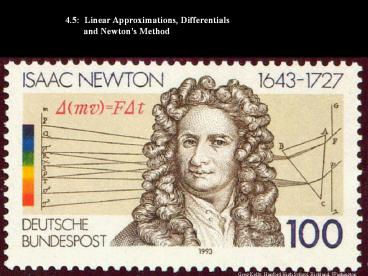Calculus 4.5 - PowerPoint PPT Presentation
1 / 18
Title:
Calculus 4.5
Description:
4.5: Linear Approximations, Differentials and Newton s Method Greg Kelly, Hanford High School, Richland, Washington For any function f (x), the tangent is a close ... – PowerPoint PPT presentation
Number of Views:65
Avg rating:3.0/5.0
Title: Calculus 4.5
1
4.5 Linear Approximations, Differentials
and Newtons Method
Greg Kelly, Hanford High School, Richland,
Washington
2
For any function f (x), the tangent is a close
approximation of the function for some small
distance from the tangent point.
3
Start with the point/slope equation
linearization of f at a
The linearization is the equation of the tangent
line, and you can use the old formulas if you
like.
4
Important linearizations for x near zero
This formula also leads to non-linear
approximations
5
Differentials
When we first started to talk about derivatives,
we said that becomes when the
change in x and change in y become very small.
dy can be considered a very small change in y.
dx can be considered a very small change in x.
6
Let be a differentiable
function. The differential is an
independent variable. The differential is
7
Example Consider a circle of radius 10. If the
radius increases by 0.1, approximately how much
will the area change?
very small change in r
very small change in A
(approximate change in area)
8
(approximate change in area)
Compare to actual change
New area
Old area
9
Newtons Method
Finding a root for
We will use Newtons Method to find the root
between 2 and 3.
10
Guess
(not drawn to scale)
(new guess)
11
Guess
(new guess)
12
Guess
(new guess)
13
Guess
Amazingly close to zero!
This is Newtons Method of finding roots. It is
an example of an algorithm (a specific set of
computational steps.)
It is sometimes called the Newton-Raphson method
This is a recursive algorithm because a set of
steps are repeated with the previous answer put
in the next repetition. Each repetition is
called an iteration.
14
Guess
Amazingly close to zero!
This is Newtons Method of finding roots. It is
an example of an algorithm (a specific set of
computational steps.)
It is sometimes called the Newton-Raphson method
This is a recursive algorithm because a set of
steps are repeated with the previous answer put
in the next repetition. Each repetition is
called an iteration.
15
Find where crosses .
16
There are some limitations to Newtons method
Looking for this root.
Bad guess.
Wrong root found
Failure to converge
17
Newtons method is built into your calculator
You could just use the root finder to answer the
problem.
The only reason to use the calculator for
Newtons Method is to help your understanding or
to check your work.
It would not be allowed in a college course, on
the AP exam or on one of my tests.
18
Now lets do one on the TI-84
Enter f(x) into the y window Enter f(x) and
unselect it Graph the function and make a
guess Go back to home screen and store your
guess as x Then type x y1/y2 and store your
answer Re-Type x y1/y2 sto X and your
calculator will store Each answer automatically
Continue to hit enter until your answers
converge Repeat for others zeros if the
function has more! Answers 1.347826087































